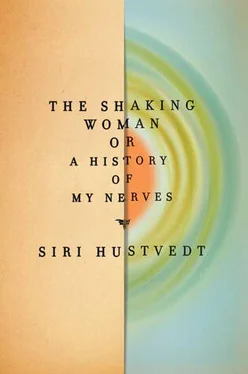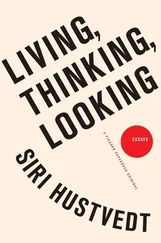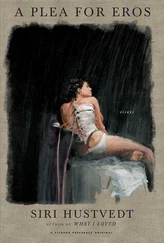I know the impact was horrible, because it returned to me those four nights, but my memory of the catastrophic instant is no longer present in my mind. I remember the time after the crash, however, with heightened clarity and precision. I remember sitting frozen in the seat, remember checking to see that I was whole without moving my head. I remember looking through the shattered glass of the windshield at the sky and that everything was black and white and gray. I remember the fireman telling me that the Jaws of Life were noisy, and I remember my indifference, an indifference so profound that I actually said to myself, If you have to die now, this is not such a bad way to go. In the ambulance, the paramedic who was monitoring my swiftly dropping blood pressure as the siren screamed above us asked me if I was particularly white. I told him that because I was of northern European stock, I was indeed white, but that people did not often comment on my whiteness. No doubt, after the accident, I had turned very pale. I didn’t know then whether or not I had broken my neck, whether or not I would die or be injured for life, but I felt neither fear nor distress. My perceptions were acute. In fact, I told myself to be alert to everything because if I did get through it, I might be able to use the material in a novel. Under the circumstances, this now strikes me as bizarre, but my distance from potential catastrophe must have served a protective, adaptive purpose: alienation as armor against the real. The little voice in my head continued on its narrative journey, talking away in a reasonable manner, but my emotions had shut down.
In their book The Haunted Self, Onno van der Hart, Ellert R. S. Nijenhuis, and Kathy Steele discuss trauma and dissociation. 37Following Janet and others, they argue that dissociative experiences are due to a division in psychobiological systems within the suffering person. Using terminology developed by Charles Myers, who studied trauma, especially among veterans of the First World War, they use Apparently Normal Personality and Emotional Personality to identify the split, or ANP and EP. Although this distinction can become unintentionally comic — her ANP did this, while her EP did that — the terms make some sense to me. The danger is that this language reduces a complex reality to something far too simple, even though the authors who use it want to maintain a sense of the intricate mechanisms involved. ANP and EP move dangerously close to multiple personality, a diagnosis that has made many people uneasy because, for a time, psychotherapists seemed to be finding multiples all over the place. Hosts and alters were everywhere, as were recovered traumatic memories, some of them highly suspicious. The DSM ’s response was to change multiple personality disorder to dissociative identity disorder, or DID. This deemphasizes the many-people-inside-one-person quality of the illness and stresses that there is something wrong with the patient’s whole identity . Rather than being several discrete persons, the multiple is a being in pieces. As Ian Hacking points out in Rewriting the Soul: Multiple Personality and the Sciences of Memory, perception changes illness: “Some physicians had multiples among their patients in the 1840s, but their picture of the disorder was very different from the one that is common in the 1990s. The doctors’ vision was different because the patients were different; but the patients were different because the doctors’ expectations were different.” 38In other words, suggestion is powerful, and human beings are far more vulnerable to it than we would like to imagine.
Hacking doesn’t argue that there aren’t traumatized people or that they don’t suffer from what can sometimes be odd symptoms. He tracks the historical development of a diagnosis that was popular in the nineteenth century and, significantly, regarded as a form of hysteria . Multiple personality receded along with hysteria and then rose again in the late twentieth century in a different form. Hacking dislikes the word dissociation because its meaning is broad and it is used to refer to a number of states. I think his objection is deepened by the fact that the word itself became a banner for the defenders of multiple personality disorder during the 1990s when wars over recovered memory were raging and psychotherapists published papers in journals called Dissociation and the International Society for the Study of Dissociation . He is right that the word has become diffuse and has been employed by doctors who may have prompted plurality in their patients through suggestion. Nevertheless, there does seem to be a defensive response in human beings that involves some form of distancing from or translation of the unbearable — proximity to one’s own death or to the deaths of others. Justine in 1874 and V.U. in 2001 inhabited different medical climates, but that doesn’t mean we can’t see similarities between them.
The strangeness of a duality in myself remains, a powerful sense of an “I” and an uncontrollable other. The shaking woman is certainly not anyone with a name . She is a speechless alien who appears only during my speeches. At one of his Harvard lectures, Janet referred to a case of hysterical trembling. “In some rare cases, you can find behind the tremors… the existence of a fixed idea separated from the consciousness. .. But, in most cases, there is nothing behind the tremor but a vague emotive state and a kind of transformation of the motor function of the limbs.” 39When addressing cases of hysterical anesthesia, he wrote, “In reality what has disappeared is not the elementary sensation… it is the faculty that enables the subject to say clearly, ‘It is I who feel, it is I who hear.’ ” 40Hysteria, from this point of view, is a derangement of subjectivity, of ownership of the self.
But who owns the self? Is it the “I”? What does it mean to be integrated and not in pieces? What is subjectivity? Is it a singular property or a plural one? I have come to think of the shaking woman as an untamed other self, a Mr. Hyde to my Dr. Jekyll, a kind of double. Doubles in literature almost always torment and sabotage the desires and ambitions of their originals and, often, they take over. Poe’s uncanny twin and rival in “William Wilson” is identical to the first William Wilson in every way except that he cannot speak above a whisper, a haunting echo of the narrator’s own voice. Dostoyevsky’s benighted hero in The Double, Mr. Golyadkin, shakes in his doctor’s office shortly before the crafty, ambitious second Mr. Golyadkin makes his appearance: “His gray eyes gleamed strangely, his lips began to quiver, all the muscles, all the features of his face began moving and working. He was trembling all over.” 41In Hans Christian Andersen’s story “The Shadow,” it is a shadow that subsumes its owner: “For now the shadow was master and the master shadow.” 42Original and copy are at war.
But doubling stories also exist outside fiction in the neurological literature. Some migraine sufferers have seen doubles of themselves as part of their auras. Known as autoscopic hallucinations, these visions are mirrors of the self. The migraineur sees her double, sometimes motionless, but often walking beside her and copying her every gesture. The neurologist Klaus Podoll, who has done extensive research on migraine auras, includes on the website he shares with his colleague Markus Dahlem a story about the Swedish botanist Carolus Linnaeus, who often saw his double before a migraine attack and once is reported to have entered a lecture hall to speak, noticed there was already someone at the lectern, and left the room. He had mistaken his own hallucinatory double for someone else. 43In a paper, Todd Feinberg and Raymond Shapiro tell the story of a patient, S.M., who had atrophy in the right temporoparietal region of her brain. S.M. mistook her own mirror image for a double, whom she referred to as the “other S.M.” Because S.M. was deaf, she used sign language to communicate with her mirror image. S.M. got along rather well with her second self, but she confessed to a few discrepancies between them. The other S.M. wasn’t as proficient at signing and wasn’t as bright as S.M. herself. 44If I were fated to see myself from the outside as another, without the ability to identify that person as myself, heaven knows what flaws I might detect. In contrast to S.M., another patient of Feinberg’s, Rosamund, detested her mirror image and, like William Wilson, treated it as an evil twin: “You tramp! Go on home… leave us alone!” 45Her fury mounted until she threatened to kill the intruder. At the very least these stories indicate that any conception of the self as unitary might be subject to revision. S.M. and Rosamund misread only their own images in the mirror, not the reflections of others, which suggests that there is something neurologically distinct about the reflective recognition of one’s self. The two women easily recognized the reflections of others in the mirror and, had either of their doctors pointed to his patient’s body and asked her to identify to whom it belonged, neither woman would have had any difficulty claiming it as her own.
Читать дальше












